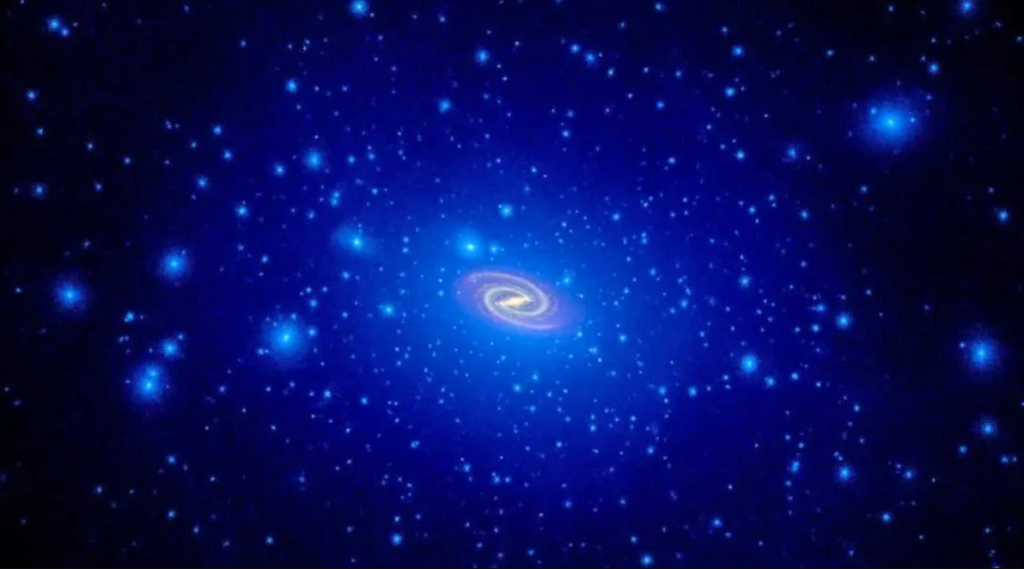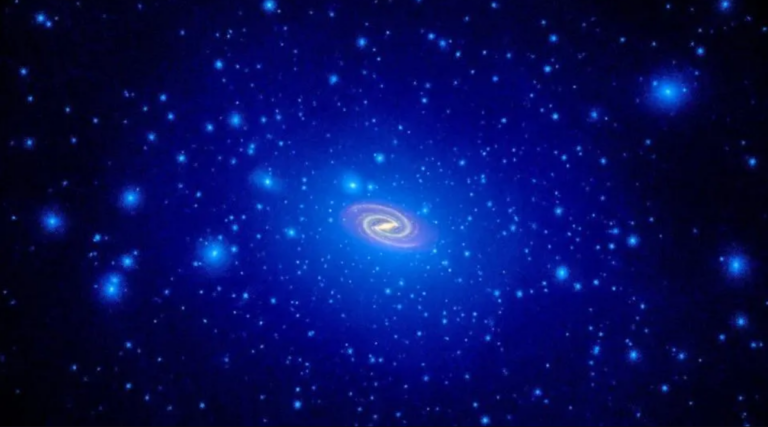How the ‘Dark Force’ Theory Resolves Two Cosmic Mysteries
Currently, there’s an intriguing prospect emerging: dark matter might possess greater complexity and dynamism than initially anticipated.
A novel theory proposes that dark matter comprises particles with strong mutual interactions governed by a phenomenon termed the “dark force.” Should this hold true, it might finally offer an explanation for the extraordinary densities observed within dark matter haloes encircling galaxies.

This concept of self-interacting dark matter (SIDM) diverges from conventional cold dark matter theories, which posit that this enigmatic substance consists of massive, sluggishly moving (hence “cold”) particles with minimal interaction and no collisions. However, these cold dark matter models encounter challenges in elucidating two specific mysteries linked to dark matter haloes.
Hai-Bo Yu, team leader and professor of physics and astronomy at the University of California, Riverside, noted, “The first enigma involves a high-density dark matter halo found in a massive elliptical galaxy. Observations of profound gravitational lensing revealed this halo, showcasing an extraordinarily dense nature that contradicts the prevailing cold dark matter theory.”
He further added, “The second puzzling aspect revolves around the dark matter haloes within ultra-diffuse galaxies, characterized by remarkably sparse densities, posing a challenge for explanation within the framework of the cold dark matter theory.”
The haloes
Dark matter poses a significant puzzle for scientists since, despite constituting approximately 85% of cosmic matter, it evades interaction with light, rendering it nearly imperceptible. This distinct characteristic suggests that dark matter isn’t merely unseen collections of conventional matter—like electrons, protons, and neutrons—comprising stars, planets, and the observable world around us. It indicates that dark matter must be composed of an alternative substance.
The sole method researchers employ to deduce the presence of dark matter hinges on its mass and consequent gravitational interactions. This gravitational effect influences visible baryonic matter and light—observable by astronomers.
Specifically, when light traverses regions enveloped by dark matter around galaxies, this substance’s gravitational influence bends the fabric of space, altering the light’s trajectory and causing background sources to appear displaced in space.
This phenomenon, termed gravitational lensing, initially enabled scientists to ascertain that most, if not all, galaxies are encircled by haloes of dark matter. These haloes are presumed to extend well beyond the boundaries of visible matter within galaxies, such as stars, gas, and dust. Gravitational lensing also aids astronomers in gauging the density of these dark matter haloes. Greater densities in haloes result in more pronounced lensing effects compared to the less dense haloes surrounding ultra-diffuse galaxies—galaxies with faint luminosity and dispersed gas and stars. Nonetheless, scientists have encountered challenges in elucidating the extremes observed in the densities of these dark matter haloes.
Enter, artificial intelligence
In an attempt to address this enigma, Yu, along with colleagues Ethan Nadler and Daneng Yang, postdoctoral researchers at the University of Southern California, developed high-resolution simulations of cosmic structures based on authentic astronomical observations.
Their simulations incorporated potent self-interactions among dark matter on mass scales relevant to robust lensing haloes and ultra-diffuse galaxies.
Nadler clarified, “These self-interactions induce heat transfer within the halo, leading to diverse central density distributions among galaxies. Put simply, certain haloes exhibit higher central densities while others display lower central densities compared to their cold dark matter counterparts. The specifics rely on the cosmic evolution history and the environment of individual haloes.”
The team’s findings suggest that self-interacting dark matter (SIDM), operating through a “dark force” akin to the interaction of baryonic particles via electromagnetism, strong, and weak nuclear forces, might resolve issues that conventional cold dark matter theories fail to address.
Yang emphasized, “Cold dark matter struggles to account for these discrepancies. SIDM emerges as a compelling candidate capable of reconciling these conflicting observations. This raises an intriguing prospect that dark matter might possess more intricacy and dynamism than initially presumed.”
Furthermore, the team believes their research demonstrates the potency of combining real-time astronomical observations, continually advancing with each generation of telescopes, with the burgeoning capabilities of artificial intelligence.
Yu expressed, “We aspire that our work motivates further exploration in this promising research domain. This becomes particularly pertinent given the anticipated surge in data from forthcoming astronomical observatories, notably the James Webb Space Telescope and the upcoming Rubin Observatory.”
The team’s research was published in November in The Astrophysical Journal Letters.
Do not forget to share your opinion with us to provide you with the best posts !





0 Comments